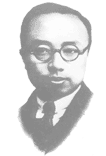Liu Tianhua
Liu Tianhua (simplified Chinese: 刘天华; traditional Chinese: 劉天華; pinyin: Liú Tiānhuá; Wade–Giles: Liu T'ien-hua; 1895–1932) was a Chinese musician and composer best known for his innovative work for the erhu. Liu's students, such as Jiang Fengzhi and Chen Zhenduo, continued to contribute to the development of the erhu.[1]
Liu Tianhua | |
|---|---|
 | |
| Background information | |
| Born | 1895 Jiangyin, Jiangsu, China |
| Origin | Jiangsu |
| Died | 1932 Beijing |
| Genres | Chinese classical |
| Instruments | Erhu, Pipa |
| Years active | early 1900s |
He was the younger brother of the poet Liu Bannong. He died in 1932 at the age of 37.[2]
Work on Chinese music
Liu was a noted erhu and pipa player, and an early pioneer in the modernisation of traditional Chinese music. He joined Cai Yuanpei's Peking University Music Society as an instrumental instructor in 1922. He promoted Chinese music while he was at Peking University, founded the Society for the Improvement of Chinese Music (國樂改進社, Guóyuè Gǎijìnshè) in 1927 and its periodical, the Music Magazine (音樂雜誌, Yīnyuè Zázhì). The society organised classes and formed a musical ensemble to play Chinese music, a forerunner of the modern Chinese orchestra. He made improvements to the traditional fiddle huqin, in particular the erhu, so that it can become an instrument suitable for a modern stage performance, and wrote music for the instrument.[3] He also made changes to the pipa, increasing the number of frets and used an equal-tempered tuning.
Compositions
Titles in pinyin, Chinese characters and English translation.
Erhu
- Bìng Zhōng Yín (病中吟) 1918 (recitation of ill-being; Soliloquy of a Convalescent)[4]
- Yuè Yè (月夜) 1924 (moon night)
- Kǔmèn zhī Ōu (苦闷之讴) 1926 (song of melancholy)
- Bēi Gē (悲歌) 1927 (song of lament)
- Liáng Xiāo (良宵) 1928 (beautiful evening)
- Xián Jū Yín (闲居吟) 1928 (recitation of leisure)
- Kōng Shān Niǎo Yǔ (空山鸟语) 1928 (bird song in a desolate mountain)
- Guāngmíng Xíng (光明行) 1931 (towards brightness)
- Dú Xián Cāo (独弦操) 1932 (Étude on a single string)
- Zhú Yĭng Yáo Hóng (烛影摇红) 1932 (shadows of candles, flickering red)
- Studies for Erhu No 1 - 47
Pipa
References
- China Medley Archived 2010-02-04 at the Wayback Machine
- Wang, Guotong; Wong, Ray. "Remembering Liu Tianhua". South China Morning Post.
- The Concise Garland Encyclopedia of World Music, Volume 2, Volume 2. Routledge. 2008. p. 1118. ISBN 978-0415994040.
- Translation on a record by Wei Chung-loh Archived 2011-07-02 at the Wayback Machine (衛仲樂), 1938
- 「虛籟」含義到底為何?: “「虛」是「空虛」、「虛無」的意思,「籟」原是古代的一種簫,因為簫的聲音是從孔穴裡發出來的,又引申為從孔穴裡發出聲音,後來人們把籟泛指為聲音,「虛籟」是指沒有聲音,或是空虛的聲音。” (Xū means empty and Lài is a classical instrument that is now generalized to mean "sound." Xū Lài therefore means "no sound" or "the sound of emptiness".)
External links
- Kōng Shān Niǎo Yǔ (空山鸟语) on YouTube
- Gē Wǔ Yǐn (歌舞引) on YouTube
- iTunes: Chinese Traditional Erhu music Vol. 1 by Lei Qiang
- Treasures Of Chinese Instrumental Music, Erhu
- iTunes: Treasures Of Chinese Instrumental Music, Erhu
